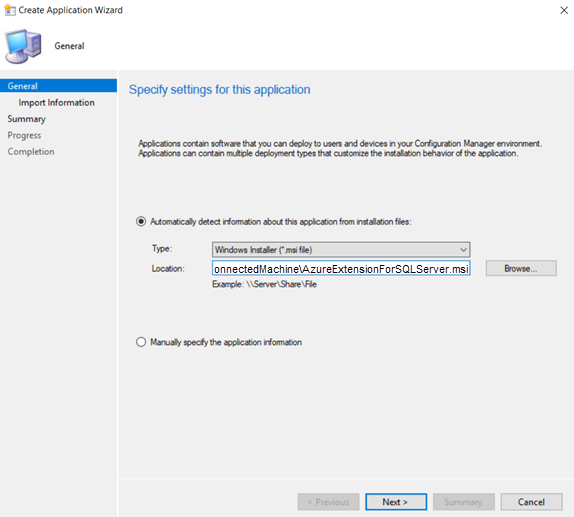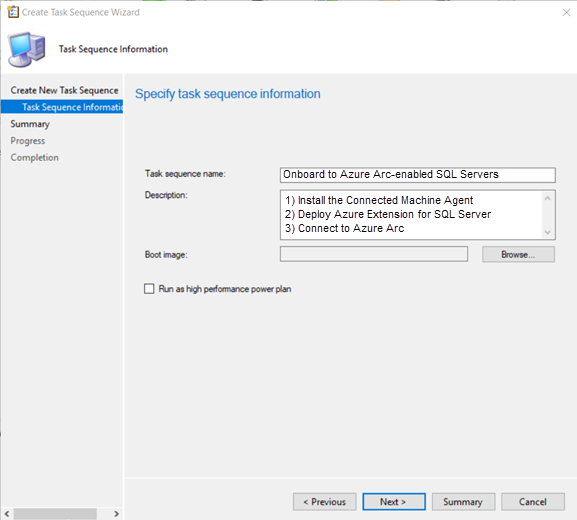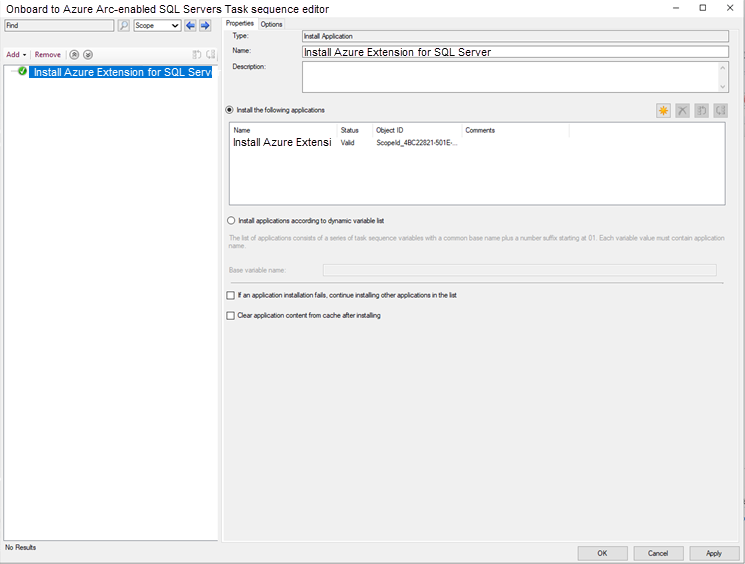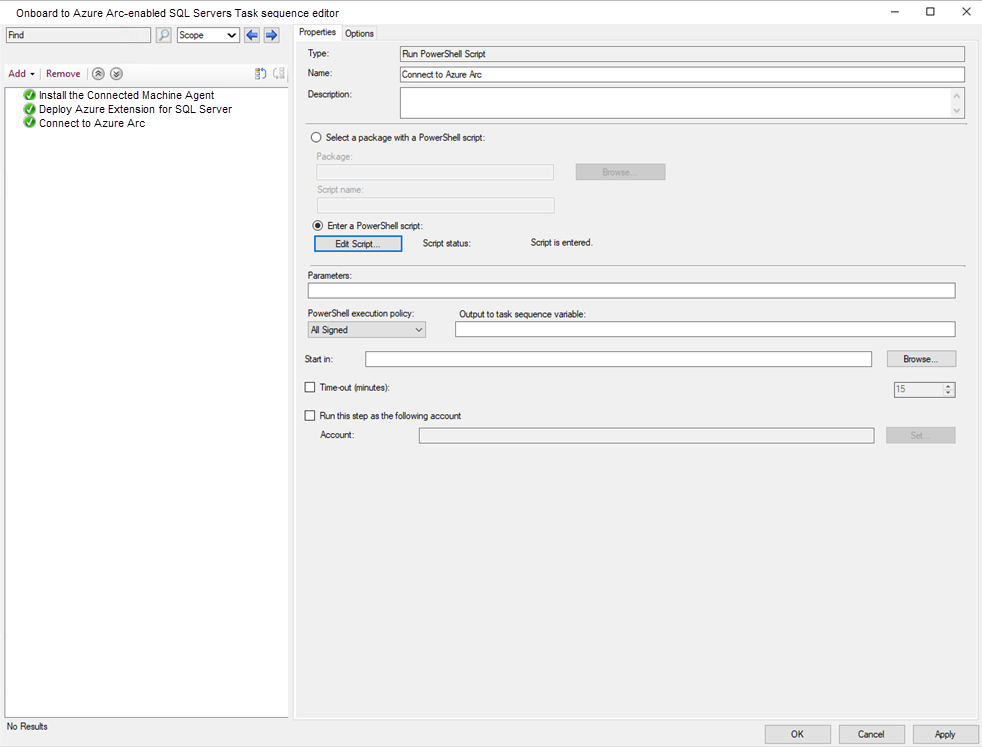Connect SQL Server machines at scale with a Configuration Manager custom task sequence
Applies to:
SQL Server
Important
Azure Arc automatically installs the Azure extension for SQL Server when a server connected to Azure Arc has SQL Server installed. All the SQL Server instance resources are automatically created in Azure, providing a centralized management platform for all your SQL Server instances.
To automatically connect your SQL Server instances, see Automatically Connect your SQL Server to Azure Arc.
Use the method in this article, if your server is already connected to Azure, but Azure extension for SQL Server is not deployed automatically.
An ArcSQLServerExtensionDeployment = Disabled tag is created on the Arc machine resource if the extension is deployed using this method.
Microsoft Endpoint Configuration Manager facilitates comprehensive management of servers supporting the secure and scalable deployment of applications, software updates, and operating systems. Configuration Manager offers the custom task sequence as a flexible paradigm for application deployment.
You can use a custom task sequence that can deploy the Connected Machine Agent to onboard a collection of devices to Azure Arc-enabled servers.
Before you get started, be sure to review the prerequisites and verify that your subscription and resources meet the requirements.
Generate a service principal
Create a Microsoft Entra ID service principal. A service principal is a special limited management identity that is granted only the minimum permission necessary to connect machines to Azure and to create the Azure resources for Azure Arc-enabled server and SQL Server enabled by Azure Arc.
Note
Microsoft Entra ID was previously known as Azure Active Directory (Azure AD).
Before you get started, be sure to review the prerequisites and assign the necessary roles and permissions to the service principal.
Download the agent and create the application
Download AzureExtensionForSQLServer.msi from the link for Windows. The .msi must be saved in a server share for the custom task sequence.
Next, create an application in Configuration Manager using the installed Azure Connected Machine agent package:
- In the Configuration Manager console, select Software Library > Application Management > Applications.
- On the Home tab, in the Create group, select Create Application.
- On the General page of the Create Application Wizard, select Automatically detect information about this application from installation files. This action pre-populates some of the information in the wizard with information that is extracted from the installation .msi file. Then, specify the following information:
- Type: Select Windows Installer (*.msi file)
- Location: Select Browse to choose the location where you saved the installation file AzureExtensionForSQLServer.msi.

- Select Next, and on the Import Information page, select Next again.
- On the General Information page, you can supply further information about the application to help you sort and locate it in the Configuration Manager console. Once complete, select Next.
- On the Installation program page, select Next.
- On the Summary page, confirm your application settings and then complete the wizard.
You have finished creating the application. To find it, in the Software Library workspace, expand Application Management, and then choose Applications.
Create a task sequence
The next step is to define a custom task sequence that installs the Azure Connected Machine Agent on a machine and deploy Azure Extension for SQL Server, then connects it to Azure Arc.
In the Configuration Manager console, go to the Software Library workspace, expand Operating Systems, and then select the Task Sequences node.
On the Home tab of the ribbon, in the Create group, select Create Task Sequence. This will launch the Create Task Sequence Wizard.
On the Create a New Task Sequence page, select Create a new custom task sequence.
On the Task Sequence Information page, specify a name for the task sequence and optionally a description of the task sequence.

After you complete the Create Task Sequence Wizard, Configuration Manager adds the custom task sequence to the Task Sequences node. You can now edit this task sequence to add steps to it.
In the Configuration Manager console, go to the Software Library workspace, expand Operating Systems, and then select the Task Sequences node.
In the Task Sequence list, select the task sequence that you want to edit.
Define Install Application as the first task in the task sequence.
- On the Home tab of the ribbon, in theTask Sequence group, select Edit. Then, select Add, select Software, and select Install Application.
- Set the name to
Install Connected Machine Agent and Azure extension for SQL Server. - Select the Azure Extension for SQL Server.

Define Run PowerShell Script as the second task in the task sequence.
- Select Add, select General, and select Run PowerShell Script.
- Set the name to
Connect to Azure Arc. - Select Enter a PowerShell script.
- Select Add Script, and then edit the script to connect to Arc as shown below. Note that this template script has placeholder values for the service principal, tenant, subscription, resource group, and location, which you should update to the appropriate values.
'& "$env:ProgramW6432\AzureExtensionForSQLServer\AzureExtensionForSQLServer.exe" --subId <subscriptionid> --resourceGroup <resourceGroupName> --location <AzureRegion> --tenantid <TenantId> --service-principal-app-id <servicePrincipalAppId> --service-principal-secret <servicePrincipalSecret> --proxy <proxy> --licenseType <licenseType> --excluded-SQL-instances <"MSSQLSERVER01 MSSQLSERVER02 MSSQLSERVER15"> --machineName <"ArcServerName">'
Select OK to save the changes to your custom task sequence.
Deploy the custom task sequence and verify connection to Azure Arc
Follow the steps outlined in Deploy a task sequence to deploy the task sequence to the target collection of devices. Choose the following parameter settings.
- Under Deployment Settings, set Purpose as Required so that Configuration Manager automatically runs the task sequence according to the configured schedule. If Purpose is set to Available instead, the task sequence will need to be installed on demand from Software Center.
- Under Scheduling, set Rerun Behavior to Rerun if failed previous attempt.
Validate successful onboarding
After you connected the SQL Server instances to Azure, go to the Azure portal and view the newly created Azure Arc resources. You'll see a new Server - Azure Arc resource for each connected machine and a new SQL Server - Azure Arc resource for each connected SQL Server instance within approximately 1 minute. If these resources aren't created, it means something went wrong during the extension installation and activation process. See Troubleshoot Azure extension for SQL Server for the troubleshooting options.

Next steps
Feedback
Coming soon: Throughout 2024 we will be phasing out GitHub Issues as the feedback mechanism for content and replacing it with a new feedback system. For more information see: https://aka.ms/ContentUserFeedback.
Submit and view feedback for